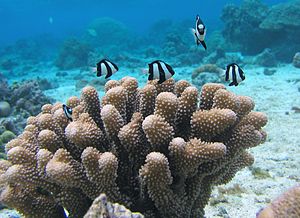Three-banded Prussian fish
| Three-banded Prussian fish | ||||||||||||
|---|---|---|---|---|---|---|---|---|---|---|---|---|

Three- banded Prussian fish over a stony coral of the species Pocillopora meandrina (photo taken in the National Park of American Samoa ) |
||||||||||||
| Systematics | ||||||||||||
|
||||||||||||
| Scientific name | ||||||||||||
| Dascyllus aruanus | ||||||||||||
| ( Linnaeus , 1758) | ||||||||||||
The Whitetail Dascyllus ( Dascyllus aruanus ) is a kind from the family of damselfish (Pomacentridae). The fish live in lagoons and coastal coral reefs in the western Pacific , north to southern Japan and south to Sydney . A line from the Line Islands over the Marquesas to the Tuamotu Archipelago forms the eastern limit of its range. The "three-banded Prussian fish" found in the Red Sea and the Indian Ocean were separated from Dascyllus aruanus in December 2014 under the scientific name Dascyllus abudafur . The limit of distribution of the two species is the Lombok Strait .
The fish live in large schools over branched Acropora sticks or in smaller groups in isolated coral sticks outside the actual reef. They feed on zooplankton , small bottom-dwelling invertebrates, and algae.
features
Three-banded Prussian fish are 6.5 centimeters long. They are high back and of a white base color. Three broad black transverse ligaments run from the base of the dorsal fin over the head to the throat, from the middle of the dorsal fin to the black pelvic fins and from the back of the dorsal fin to the anal fin . The caudal fin is white. They have 15 to 19 scales along the lateral line organ . The number of gill trap processes is 21 to 26.
Fins formula : dorsal XII / 11–13, anals II / 11–13, pectorals 17–19
Aquaristics
Three-banded Prussian fish were popular ornamental fish in saltwater aquariums and are also suitable for beginners. Because of the import of more colored fish and their tendency to aggressive behavior, they are no longer imported as often. The animals are territorial in the aquarium . With good care, they spawn in the aquarium. Scientists once also managed to raise the larvae. The larvae hatch after three to five days.
literature
- Gerald R. Allen : Damselfish of the World . Mergus Verlag, Melle 1991, ISBN 3-88244-007-4
Individual evidence
- ↑ Philippe Borsa, Andrianus Sembiring, Cécile Fauvelot, Wei-Jen Chen (2014): Resurrection of Indian Ocean humbug damselfish, Dascyllus abudafur (Forsskål) from synonymy with its Pacific Ocean sibling, Dascyllus aruanus (L.) Comptes Rendus Biologies, Volume 337 , Issue 12, December 2014, pages 709–716. doi: 10.1016 / j.crvi.2014.09.001
Web links
- Three-banded Prussian fish on Fishbase.org (English)